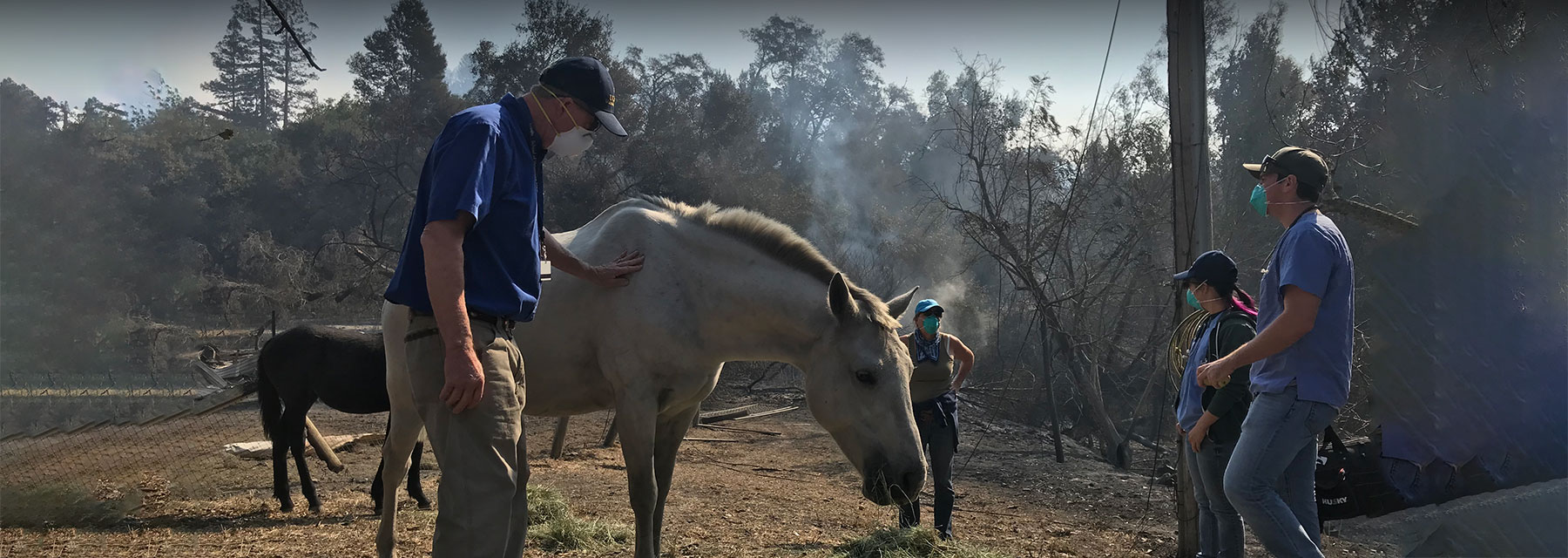Managing Horses During Mother Nature's Emergencies
Wildfires. Hurricanes. Floods. Tornadoes. When Mother Nature is at her worst, will you and your horses be prepared for an emergency evacuation?
Disaster planning is critical when you own horses, and helps ensure the best chance of survival for you and your animals during emergencies. Whether you shelter in place or evacuate with or without your horses, your top priority must be to first ensure your safety and the safety of your family and farm or ranch employees. Evacuating large animals can be challenging, especially in situations where little warning is given, such as with a fast-moving wildfire or tornado. Managing a successful evacuation requires careful planning before any disaster or emergencyoccurs. By taking the time to develop a thoroughly-detailed Emergency Action Plan (EAP) now, you have a much better chance of protecting your family and saving your animals and your business.
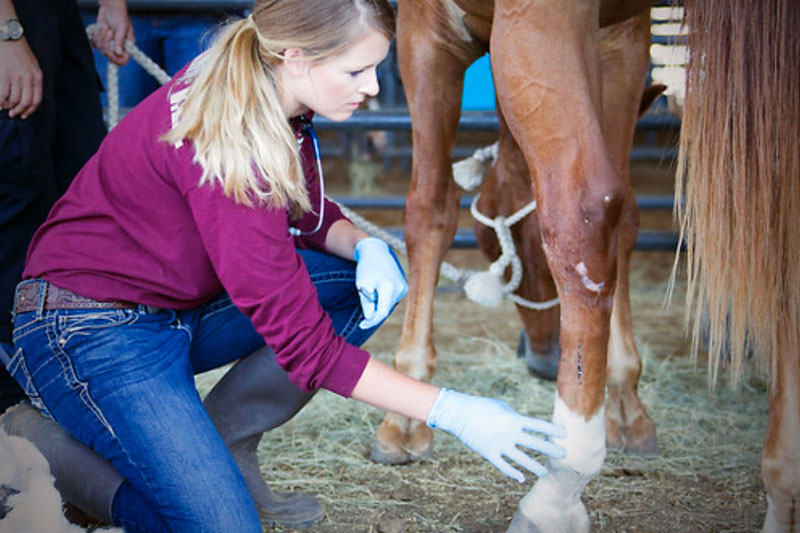
A veterinarian evaluates lacerations on a horse's leg that happened during Hurricane Harvey.
PHOTO COURTESY OF TEXAS A&M
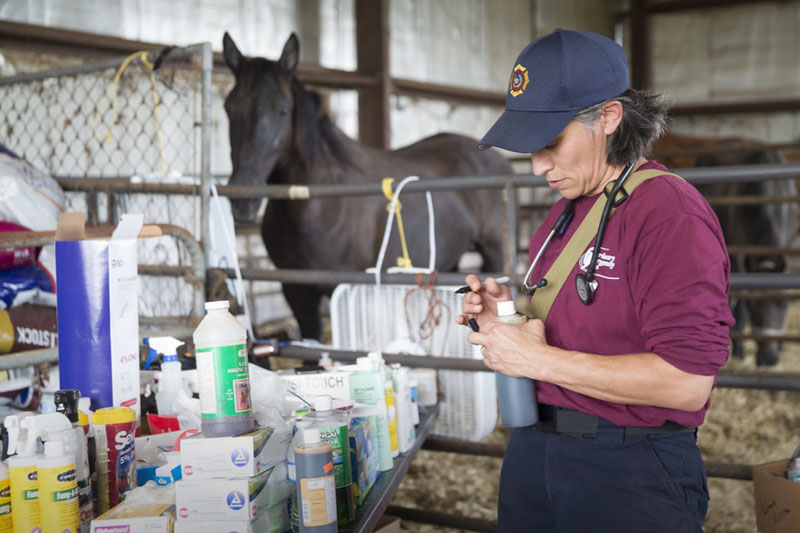
A member of Texas A&M University's Veterinary Emergency Team (VET) works with horses post Hurricane Harvey. In the aftermath of Hurricane Harvey, the VET deployed to 11 different counties along the Texas coastline.
PHOTO COURTESY OF TEXAS A&M
Left, a veterinarian evaluates lacerations on a horse's leg that happened during Hurricane Harvey.
Right, A member of Texas A&M University's Veterinary Emergency Team (VET) works with horses post Hurricane Harvey. In the aftermath of Hurricane Harvey, the VET deployed to 11 different counties along the Texas coastline.
PHOTOS COURTESY OF TEXAS A&M
Be Prepared: Before an Emergency
There are three primary areas of preparation that you can take to be ready for any emergency. These include developing an EAP, learning about and signing up for the emergency alerts that are available in your area and, finally, becoming situationally aware of the disasters that might affect you and your animals, so you can decide on the safest time to evacuate if necessary.
1. The Emergency Action Plan (EAP)
An emergency action plan is an essential organizational document that will help to ensure an orderly and efficient evacuation of your property. Planning is the key to a successful evacuation strategy, so take time beforehand to develop an EAP that is unique to your farm or ranch. As with most disaster preparedness plans, the EAP is also organized into sections including “before,” “during” and “after” an emergency.
EAP items to gather and organize before an emergency occurs include:
- Information about the farm or ranch (location, ownership, people who typically live or work at the facility)
- Emergency contacts and local resources that could aid in the emergency
- A map of the farm or ranch with detailed plans on evacuation routes, an animal inventory, a list of equipment available for the emergency (trailers, trucks, cars, tractors, etc.)
- Ways to manage the farm or ranch to limit losses (sprinkler systems, backup power sources, insurance policies)
During an emergency, the EAP helps provide guidelines on how to get information about the emergency, how to decide what to do with the animals (shelter in place or at a specific location on the farm or ranch, or transport the animals to another location) and details about how to move or relocate the animals if necessary. It also includes packing lists appropriate for owners, workers and for affected animals. If an emergency does occur, the EAP has information that is helpful after the event, including checklists to help evaluate any loss of animals, guidelines for an assessment of damage to the property, lists of insurance policies and company contacts, and instructions on how to move forward with recovery.
When emergencies could require an immediate evacuation, possibly without warning, it is essential to not only have an EAP in place but to also have had a practical walk-through of the steps that you, your family and your staff will take to ensure that everyone and all of the animals under your care remain safe. Having all people on the property familiar with the EAP and the unique role that each person plays in carrying out the steps outlined in it, the more likely you are to have a calm, efficient and safe evacuation. If your barn or ranch staff are fluent in a different language, the EAP should be translated and easily understandable for all involved.
“Make a detailed plan, stay calm and execute the plan as soon as you know that a disaster is headed your way. It is far better to evacuate early than to wait and not be able to get out,” says Dr. Leslie Easterwood, Texas A&M University, Clinical Assistant Professor of Equine Community Practice and member of the Veterinary Emergency Team (VET).
Horse owners are strongly encouraged to have all horses halter broke and trained to load into a trailer during non-emergent times and in inclement weather conditions, so that if and when an evacuation order is issued, the horses can be safely loaded whether the evacuation occurs during daylight or nighttime hours. Critical information like evacuation routes from your property along with phone trees and contact lists must be easily accessible to everyone working at your facility. It is always a good idea to plan for alternate routes of evacuation and to have printed maps of your area available in case you encounter road closures or in case cell phone service is disrupted and mobile access to street maps is unavailable. In some cases, transportation may need to be arranged if a trailer is not available on-site. If help is needed to load and move your horses during a crisis, don’t leave anything to chance. Make sure that neighbors or the people that you are counting on to help with transport are aware that they are part of your plan. Don’t assume they know.
2. Emergency Alerts
Depending on where you live and your proximity to city versus rural areas, you may have different options available to you that will provide an alert during an emergency or natural disaster. Many communities use an alert system called Nixle, which will provide information about emergency alerts and advisories. In order to receive these updates, you need to register your mobile number with Nixle, which can be done by texting your ZIP code to 888777. In regions of the country where Nixle is not available, you can contact your local Office of Emergency Services (OES), police or fire department to see what alert systems are available. Register your cell phone, land line and e-mail address to help ensure you receive an alert.
A key feature of any emergency alert system is that you need to ensure there is redundancy built into the alert process. In recent years, wildfires in the West have caused destruction of cell phone towers, eliminating a critical link for mobile alerts either by phone or text. Local emergency systems using 911 may also become overwhelmed and be unable to provide assistance in an emergency. If one system is inoperable, you will need to decide on a backup alert to use. Some options include a community telephone communication tree, police or fire alerts, information provided through the National Weather Service (NWS) and the National Oceanic and Atmospheric Administration (NOAA) available using a NOAA weather radio, a ham radio network and social media outlets, like Twitter, that provide almost real-time information about fast-moving weather events like wildfires and tornadoes.
3. Situational Awareness
In order to safely evacuate in a timely manner, it is essential that horse owners, as well as farm and ranch owners and managers, maintain an awareness of the weather and of natural disasters that could affect their horses, livestock and property. It is helpful to know what is involved with a weather “watch” and a weather “warning.” A “watch” is issued when the risk of a hazardous weather or hydrologic event has increased significantly, but its occurrence, location and/or timing is still uncertain. It is intended to provide enough lead time, so that those who need to set their plans in motion can do so. A “warning” is issued when a hazardous weather or hydrologic event is occurring, is imminent or has a very high probability of occurring. A warning is used for conditions posing a threat to life or property. Wherever you live, practice paying attention to changing weather conditions that may bring the risk of weather-related emergencies to your area.
Regionally, different disaster scenarios may play out due to weather and geographic conditions. States along the Gulf Coast and Southern United States frequently manage hurricanes and their aftermath, while states in the western part of the U.S. are plagued with wildfires throughout the year. These different weather events affect the amount of time that a horse owner has to initiate their EAP and begin any necessary evacuation. Hurricanes tend to be relatively slow moving, and although exact landfall locations are often unknown, regions that may be affected by the winds, rain and storm surge from a hurricane usually have at least 3 to 5 days of warning, so evacuation preparations can be made. Wildfires can erupt at any time of the day or night, and during any month of the year currently. Red Flag Warnings, which occur during extreme fire weather conditions, often precede the start of fires that can rapidly grow into a mega fire and then develop into pyrocumulonimbus fire clouds, firenadoes and exceedingly dangerous fires which, when driven by the wind, can propel embers and sparks up to 1 to 1.5 miles beyond a main fire line. In these types of conditions, mandatory evacuations can be necessary, often without warning, and can occur during the overnight hours. Consider having to evacuate your farm or ranch in the middle of the night, after the power has gone out, as a fire or tornado is racing down a hillside toward your property. Being familiar with the steps you need to take to make a safe and efficient evacuation of yourself and your animals could be the difference between life and death.
When asked, “What are the three most effective methods for preventing injury to a horse during a wildland fire?” Dr. John Madigan, DVM, Diplomate American College of Animal Welfare, Distinguished Professor Emeriti and Advisor, U.C. Davis Veterinary Emergency Response Team (VERT) stated (CEH Horse Report article “Should You Turn Horses Loose With a Rapidly Moving Approaching Fire?”): 1) Evacuate early, 2) Evacuate early and 3) Evacuate early.
The importance of an early evacuation from a potentially dangerous natural disaster situation like a wildland fire or a hurricane simply cannot be understated. Once you have an EAP in place and know how to receive emergency alerts, you will be well prepared for an emergency evacuation should one be necessary.
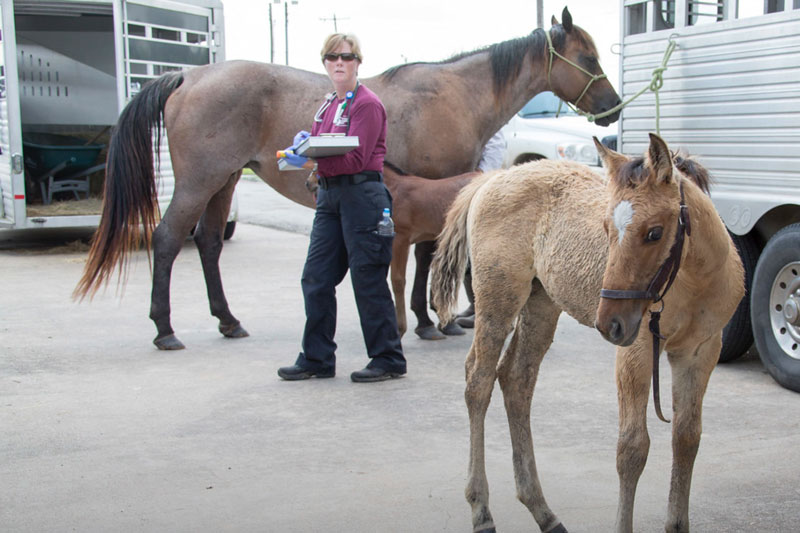
These horses are being evaluated after being rescued following the Brazoria County flood in 2016.
PHOTO COURTESY OF TEXAS A&M
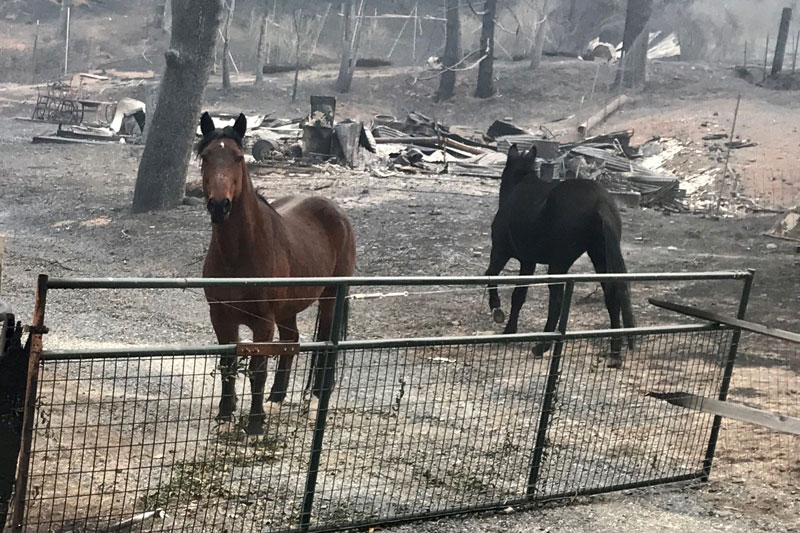
Horses that were found following the wildfires in Sonoma County.
PHOTO COURTESY OF TEXAS A&M
Left, these horses are being evaluated after being rescued following the Brazoria County flood in 2016.
Right, horses that were found following the wildfires in Sonoma County.
PHOTOS COURTESY OF TEXAS A&M
“Make a detailed plan, stay calm and execute the plan as soon as you know that a disaster is headed your way.”
— Dr. Leslie Easterwood, Texas A&M University, Clinical Assistant Professor of Equine Community Practice and Member of the Veterinary Emergency Team (VET)
Preparing to Go: Essentials
The Go-Bag
Easily accessible, ready to go and stored in waterproof bags or containers.
-
First Aid Kit
-
Veterinary and medical records for all animals
-
Two-week supply of medications
-
Extra lead ropes and halters
-
Blankets, towels, leg wraps
-
Hoof care supplies
-
Knife and multi-purpose tool
-
Work clothes, gloves and boots
-
3- to 5-Day supply of food and water per horse
Trucks and Trailers
Inspected, reliable and ready to be used.
- •Inflated tires with good tread
- •Working headlights and taillights
- •Full gas tank
- •Sturdy flooring
- •Cell phone charger
- •Separate cell phone battery
- •Printed maps of the local area help with planning an evacuation if there are unexpected road closures due to an emergency
Animal Identification
It is not uncommon for animals to be separated from their owners in an emergency. Identifying your animal may be an essential part of the recovery process. Identification ideas include:
- •Microchip, tattoo or ear tag
- •Braid contact information (i.e., luggage tag) into the horse’s mane or tail
- •Use a grease pencil to mark a phone number on the horse’s body
- •Keep photos of the horses from different angles in your Go-Bag to show any distinctive hair coat markings. Include information such as age, sex and breed.
- •Clip a phone number in the horse’s hair coat
- •Use a Sharpie® to mark information on light colored hair areas or on the horse’s hooves
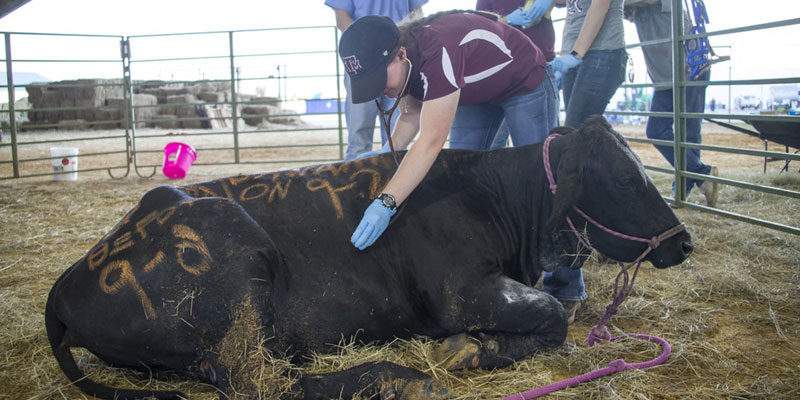
It’s Time: During an Emergency
During an emergency, it is essential that you and your employees remain situationally aware of the changing weather or emergency conditions in your area and ensure that you are receiving timely updates to understand if your area is under a particular extreme weather watch or warning. When an evacuation advisory or a mandatory evacuation order has been issued, then it is time to activate your EAP to ensure the timely evacuation of yourself, your family, your pets and your horses and livestock.
Activate Your EAP
The unique disaster scenario that you face will help to dictate whether or not you choose to start the evacuation of your horses when an evacuation advisory is issued. In areas affected by wildland fires, the choice may be to leave as soon as you realize that your property could be in the path of a wildfire. If this is the case, then by following your EAP, you likely will have activated a transportation plan to move your animals. A first step once an evacuation order is given is to communicate the potential for evacuating to your family and employees on the property, so a crew can prepare your property and ready your horses for movement. Your EAP should include evacuation routes that can be followed not only to evacuate from your property but also routes that can be followed to escape natural disasters like fires or floods that could impact and close off certain exit routes.
In certain disaster scenarios, you may decide that sheltering in place makes the most sense to ensure the safety of you and your horses. If that decision is made, once an advisory has been issued, you can begin to take the steps needed if necessary to move your animals to the designated safe spot on your property. It is vitally important that if you DO leave your horses on your property when you evacuate, that you leave signage about the number of animals remaining on your property. Written on a fluorescent sign, your animal inventory may be seen by first responders who might have the chance to evacuate your animals after you have left the property. Your EAP should include ways to identify all of your horses if you are separated from them following an evacuation.
Property protection may be part of your EAP, but remember that ensuring the safe evacuation of all people must always take priority over saving your horses, livestock and property. When the local authorities tell you to evacuate, follow their instructions. Do not linger on your property because that could endanger not only your life, but the lives of first responders who may have to come to your rescue if you become trapped.
CARTs, DARTs and VERTs
In recent years, community organizations have developed solely focused on assisting animal owners with evacuations during emergency situations. Some of the more common groups are called Community Animal Response Teams (CARTs) and Disaster Animal Response Teams (DARTs). Members of CART and DART groups work with the local Office of Emergency Services and typically have specialized training about how to handle animals (domestic and wild) that have been injured during a natural disaster. Independent and unofficial groups are often formed in an area to help aid in animal evacuations and may offer some assistance with transporting animals, although members usually do not have the same level of formal disaster assistance training as CART or DART workers.
Before an emergency strikes your area, it is best to determine if any organization exists that could help you with an evacuation of your horses and livestock if needed. If there are groups available, it is ideal to contact them before an emergency happens, so you can learn about their protocols for evacuation. Contact numbers for these types of community groups should be posted in an area that is easily accessible to all of the farm or ranch workers.
Veterinary Emergency Response Teams (VERTs) are typically called out to work in a disaster area to provide medical care to animals that have been left behind or that have been affected by the disaster and need emergency medical care. Specialized training is required for all VERT members, and typically VERTs work with the local authorities to gain access to areas where animals may be trapped and blocked to the public.
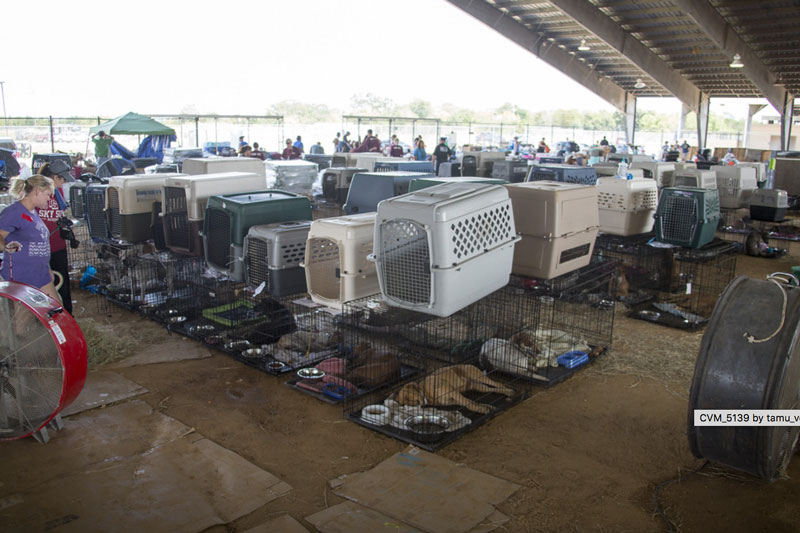
Hurricane Harvey displaced many dogs from their homes.
PHOTO COURTESY OF TEXAS A&M
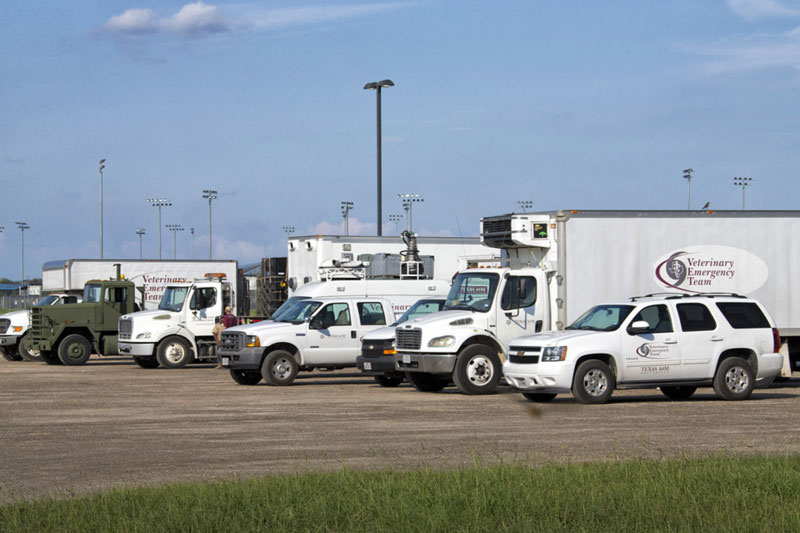
Texas A&M University's Veterinary Emergency Team (VET) has quite a fleet that responds after an emergency.
PHOTO COURTESY OF TEXAS A&M
Left, Hurricane Harvey displaced many dogs from their homes. Right, Texas A&M University's Veterinary Emergency Team (VET) has quite a fleet that responds after an emergency.
PHOTOS COURTESY OF TEXAS A&M
Rebuilding: After an Emergency
The effects of a natural disaster or emergency scenario can seem overwhelming in the days following the event. There are many areas that will require your focus and attention if your home, farm or ranch is affected by a natural disaster. If you evacuated, do not return to your home, farm or ranch until authorities allow you to do so. Often certain areas that have been devastated by a disaster will remain unsafe, with hazards that you may not be able to see. Downed power lines and damaged trees can unexpectedly fall and can cause harm or loss of life after a primary disaster has passed. Authorities know that you want to return to see what remains of your home and business as soon as possible. Be patient and don’t put your life, or the lives of first responders, in jeopardy.
If your animals remained at your property during an evacuation period, you will need to ensure that they have adequate food and water supplies and closely examine all your horses and livestock for health problems that may develop during or after the emergency event, and seek veterinary care when necessary. Some physical trauma may be very apparent, like a burn scar following a wildland fire, or a laceration or foreign body impalement from a tornado, or lower limb swelling following immersion in water for days if there has been a flood or hurricane. Other health issues may not be as apparent, like lung damage following smoke inhalation. An examination by a veterinarian is always recommended when you have any concerns about any of your animals. Understand that if your area has been affected by the disaster, veterinary care may be limited or delayed due to the overwhelming need.
If animals are missing from your property, you will, of course, be anxious to find them. A good starting point for locating them is to contact local government agencies, county animal control and county emergency officials. When your animals have been located, be sure to bring verification of ownership that could include pictures, registration papers, Coggins papers, etc. Bring anything you can provide to prove that the animal is yours.
You will need to document and evaluate the effects of the disaster on the day-to-day workings of your farm or ranch. This includes an examination of the affected property to assess the damage that has occurred, accounting for any animals that were lost due to the disaster and notification of appropriate insurance agents to begin the process of reimbursement for property and business losses, and if appropriate, the loss of insured animals. It is helpful to take photos or a video of the damage that exists on the property for insurance purposes. Emergency funds may be available to assist in the recovery and rebuilding process and should be pursued.
One of the most important steps is to help your family recover from the event both physically and emotionally. If you experience the loss of property, or worse, beloved animals, the recovery process may result in an even greater emotional burden than that felt with the loss of property. Working with professionals skilled in disaster recovery as well as medical professionals may be helpful. Communicating shared experiences with other community members can also provide a needed outlet for emotional recovery. Remember that others around you have likely just gone through the same trauma that you have. There is never a better time to show grace, lend a helping hand and provide neighborly care and support to one another.
First Aid Kit Checklist
Always seek veterinary care as soon as possible but keep in mind there might be a high demand after a disaster.
-
Gauze pads or nonstick bandages
-
Rolls of sheet cotton and cotton gauze for limb wounds
-
Bandage scissors
-
Nonstick bandages, clean cloth strips or towels (to control bleeding)
-
Adhesive tape (be cautious when applying and never tighten the tape around a limb)
-
Digital thermometer
-
Stethoscope
-
Syringes (sterile) of various sizes
-
Saline solution (sterile)
-
Stainless steel bowl (to use when rinsing or cleaning wounds)
-
Isopropyl alcohol
-
Antibiotic ointment for wounds
-
Ophthalmic ointment (WITHOUT STEROIDS)
-
Disinfectant soap (Betadine [povidone-iodine] or Nolvasan® [chlorhexidine]) and sponges or gauze to clean wounds
-
Diapers or other absorbent pads (to manage bleeding or fluid loss)
-
1-2 gallons water to rinse wounds
-
Disposable razors (to shave hair around wounds during cleaning)
-
Latex gloves (to wear while cleaning wounds)
-
Hemostats
-
Headlamp to aid in visualizing wounds
-
Splint material (6” PVC pipe cut in half — need appropriate padding between the PVC pipe and limb prior to application)
-
Pliers (to remove nails)
